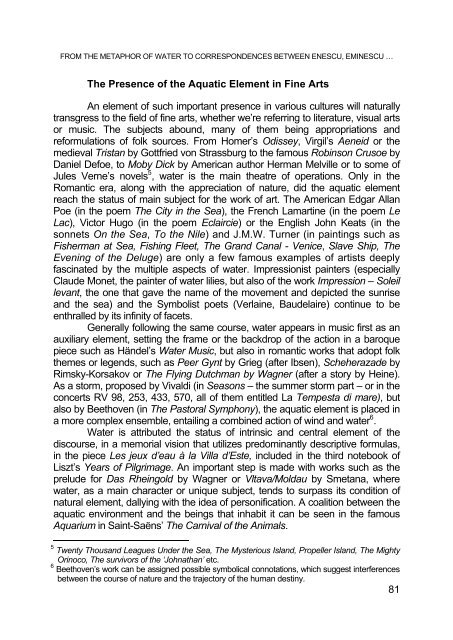musica - Studia
musica - Studia
musica - Studia
You also want an ePaper? Increase the reach of your titles
YUMPU automatically turns print PDFs into web optimized ePapers that Google loves.
FROM THE METAPHOR OF WATER TO CORRESPONDENCES BETWEEN ENESCU, EMINESCU …<br />
The Presence of the Aquatic Element in Fine Arts<br />
An element of such important presence in various cultures will naturally<br />
transgress to the field of fine arts, whether we’re referring to literature, visual arts<br />
or music. The subjects abound, many of them being appropriations and<br />
reformulations of folk sources. From Homer’s Odissey, Virgil’s Aeneid or the<br />
medieval Tristan by Gottfried von Strassburg to the famous Robinson Crusoe by<br />
Daniel Defoe, to Moby Dick by American author Herman Melville or to some of<br />
Jules Verne’s novels 5 , water is the main theatre of operations. Only in the<br />
Romantic era, along with the appreciation of nature, did the aquatic element<br />
reach the status of main subject for the work of art. The American Edgar Allan<br />
Poe (in the poem The City in the Sea), the French Lamartine (in the poem Le<br />
Lac), Victor Hugo (in the poem Eclaircie) or the English John Keats (in the<br />
sonnets On the Sea, To the Nile) and J.M.W. Turner (in paintings such as<br />
Fisherman at Sea, Fishing Fleet, The Grand Canal - Venice, Slave Ship, The<br />
Evening of the Deluge) are only a few famous examples of artists deeply<br />
fascinated by the multiple aspects of water. Impressionist painters (especially<br />
Claude Monet, the painter of water lilies, but also of the work Impression – Soleil<br />
levant, the one that gave the name of the movement and depicted the sunrise<br />
and the sea) and the Symbolist poets (Verlaine, Baudelaire) continue to be<br />
enthralled by its infinity of facets.<br />
Generally following the same course, water appears in music first as an<br />
auxiliary element, setting the frame or the backdrop of the action in a baroque<br />
piece such as Händel’s Water Music, but also in romantic works that adopt folk<br />
themes or legends, such as Peer Gynt by Grieg (after Ibsen), Scheherazade by<br />
Rimsky-Korsakov or The Flying Dutchman by Wagner (after a story by Heine).<br />
As a storm, proposed by Vivaldi (in Seasons – the summer storm part – or in the<br />
concerts RV 98, 253, 433, 570, all of them entitled La Tempesta di mare), but<br />
also by Beethoven (in The Pastoral Symphony), the aquatic element is placed in<br />
a more complex ensemble, entailing a combined action of wind and water 6 .<br />
Water is attributed the status of intrinsic and central element of the<br />
discourse, in a memorial vision that utilizes predominantly descriptive formulas,<br />
in the piece Les jeux d’eau à la Villa d’Este, included in the third notebook of<br />
Liszt’s Years of Pilgrimage. An important step is made with works such as the<br />
prelude for Das Rheingold by Wagner or Vltava/Moldau by Smetana, where<br />
water, as a main character or unique subject, tends to surpass its condition of<br />
natural element, dallying with the idea of personification. A coalition between the<br />
aquatic environment and the beings that inhabit it can be seen in the famous<br />
Aquarium in Saint-Saëns’ The Carnival of the Animals.<br />
5 Twenty Thousand Leagues Under the Sea, The Mysterious Island, Propeller Island, The Mighty<br />
Orinoco, The survivors of the ‘Johnathan’ etc.<br />
6 Beethoven’s work can be assigned possible symbolical connotations, which suggest interferences<br />
between the course of nature and the trajectory of the human destiny.<br />
81

















